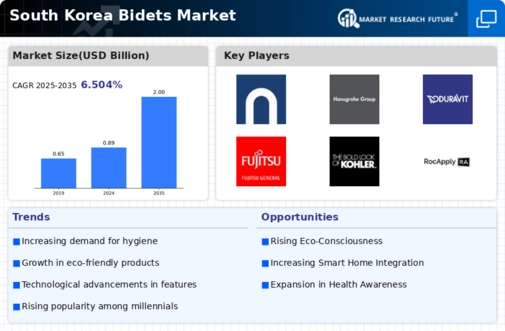The South Korea Bidets Market is characterized by its rapidly evolving landscape, where consumer preferences and advancements in technology have led to increased competition among various brands. The market is underscored by a growing emphasis on hygiene and comfort, coupled with a cultural shift that embraces modern bathroom conveniences. Companies are increasingly innovating their product offerings to capture the attention of discerning consumers seeking not only functionality but also stylish design and eco-friendliness. This competitive arena sees both international and local players striving to carve out their niche, utilizing unique value propositions that resonate with South Korean customers.
Understanding the dynamics among these competitors is crucial for identifying market trends, growth opportunities, and potential threats. Brondell has carved out a respectable presence in the South Korea Bidets Market, known for its commitment to delivering high-quality products that align with consumers' priorities of comfort and efficiency. The brand has focused on integrating advanced technology into its bidet solutions, offering features such as heated seats, adjustable water pressure, and customizable settings that enhance user experience. Brondell's strengths lie in its ability to combine affordability with premium features, making its products accessible to a wider audience.
Moreover, the brand emphasizes sustainability through energy-efficient designs, appealing to environmentally conscious consumers in South Korea. This strategic approach positions Brondell favorably in a market where health, hygiene, and eco-friendliness are increasingly crucial considerations for buyers. TOTO stands as a formidable player in the South Korea Bidets Market, recognized for its premium offerings and extensive product range that includes various types of bidets and washlets. With a strategic focus on innovation and user-centric design, TOTO's products often feature state-of-the-art technology, such as advanced cleansing systems, air dryers, and deodorizing functionalities.
The company's strong market presence is bolstered by its reputation for durability and reliability, catering to consumers who seek quality investment in bathroom fixtures. Furthermore, TOTO has engaged in strategic partnerships and collaborations, enhancing its competitive edge while expanding its service offerings in South Korea. The focus on high-end models allows TOTO to dominate the premium segment of the market, while their ongoing commitment to research and development ensures they remain a key player, continually adapting to the changing needs of South Korean consumers.





















Leave a Comment